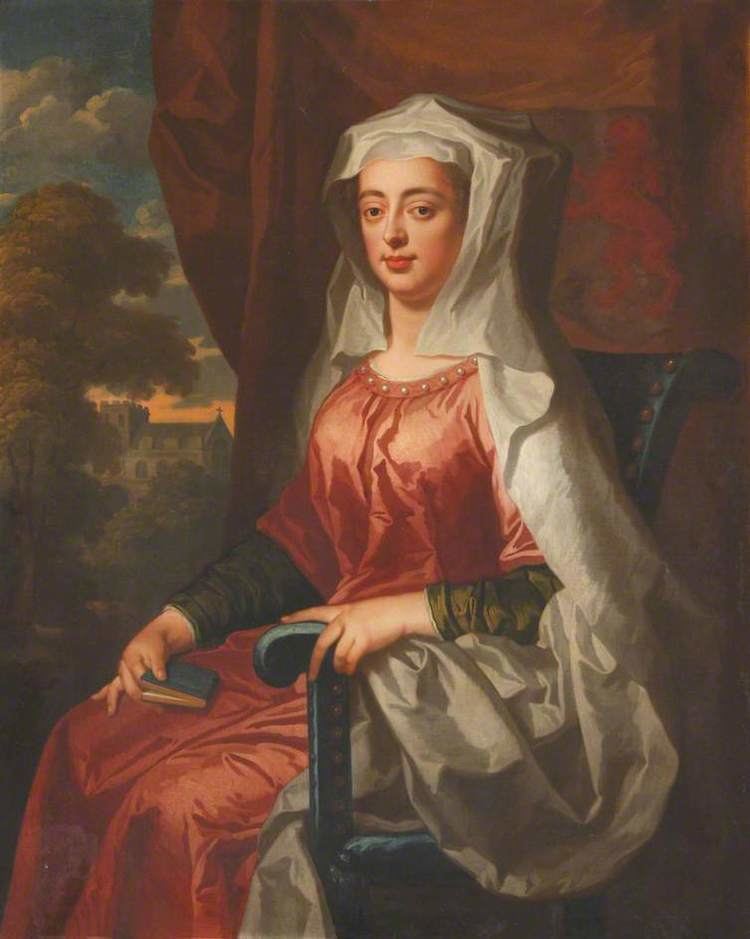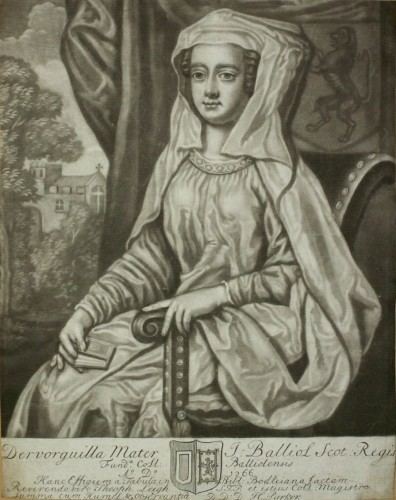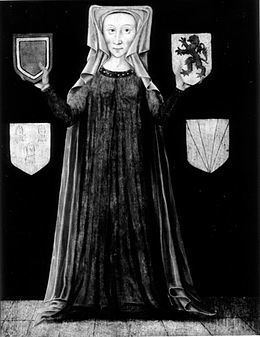Children John Balliol Name Dervorguilla Galloway | ||
 | ||
Issue Hugh, Lord of BywellAlexander, Lord of BywellAlanJohn, King of ScotlandAda de Lindsay of LambertonCecily de Burgh of WakerleyMargaretEleanor, Lady of BadenochMaud, Lady FitzAlan Died January 28, 1290, Kempston, United Kingdom Spouse John I de Balliol (m. 1223) Parents Alan of Galloway, Margaret of Huntingdon, Lady of Galloway Grandparents Matilda of Chester, Countess of Huntingdon Similar People John Balliol, John I de Balliol, Edward Balliol | ||
Dervorguilla of Galloway (c. 1210 – 28 January 1290) was a 'lady of substance' in 13th century Scotland, the wife from 1223 of John, 5th Baron de Balliol, and mother of John I, a future king of Scotland.
Contents

The name Dervorguilla or Devorgilla was a Latinization of the Gaelic Dearbhfhorghaill (alternative spellings, Derborgaill or Dearbhorghil).

Family
Dervorguilla was one of the three daughters and heiresses of the Gaelic prince Alan, Lord of Galloway. She was born to Alan's second wife Margaret of Huntingdon, who was the eldest daughter of David of Scotland, 8th Earl of Huntingdon and Matilda (or Maud) of Chester. David in turn was the youngest brother to two Kings of Scotland, Malcolm IV and William the Lion. Thus, through her mother, Dervorguilla was descended from the Kings of Scotland, including David I.
Dervorguilla's father died in 1234 without a legitimate son (he had an illegitimate son Thomas). According to both Anglo-Norman feudal laws and to ancient Gaelic customs, Dervorguilla was one of his heiresses, her two sisters Helen and Christina being older and therefore senior. This might be considered an unusual practice in England, but it was more common in Scotland and in Western feudal tradition. Because of this, Dervorguilla bequeathed lands in Galloway to her descendants, the Balliol and the Comyns. Dervorguilla's son John of Scotland was briefly a King of Scots too, known as Toom Tabard (Scots: 'puppet king' literally "empty coat").
Life
The Balliol family into which Devorguilla married was based at Barnard Castle in County Durham, England. Although the date of her birth is uncertain, her apparent age of 13 was by no means unusually early for betrothal and marriage at the time.
In 1263, her husband Sir John was required to make penance after a land dispute with Walter Kirkham, Bishop of Durham. Part of this took the very expensive form of founding a College for the poor at the University of Oxford. Sir John's own finances were less substantial than those of his wife, however, and long after his death it fell to Devorguilla to confirm the foundation, with the blessing of the same Bishop as well as the University hierarchy. She established a permanent endowment for the College in 1282, as well as its first formal Statutes. The college still retains the name Balliol College, where the history students' society is called the Devorguilla society and an annual seminar series featuring women in academia is called the Dervorguilla Seminar Series. While a Requiem Mass in Latin was sung at Balliol for the 700th anniversary of her death, it is believed that this was sung as a one-off, rather than having been marked in previous centuries.
Devorguilla founded a Cistercian Abbey 7 miles south of Dumfries in South West Scotland, in April 1273. It still stands as a picturesque ruin of red sandstone.
When Sir John died in 1269, his widow, Dervorguilla, had his heart embalmed and kept in a casket of ivory bound with silver. The casket travelled with her for the rest of her life. In 1274–5 John de Folkesworth arraigned an assize of novel disseisin against Devorguilla and others touching a tenement in Stibbington, Northamptonshire. In 1275–6 Robert de Ferrers arraigned an assize of mort d'ancestor against her touching a messuage in Repton, Derbyshire. In 1280 Sir John de Balliol's executors, including his widow, Devorguilla, sued Alan Fitz Count regarding a debt of £100 claimed by the executors from Alan. In 1280 she was granted letters of attorney to Thomas de Hunsingore and another in England, she staying in Galloway. The same year Devorguilla, Margaret de Ferrers, Countess of Derby, Ellen, widow of Alan la Zouche, and Alexander Comyn, Earl of Buchan, and Elizabeth his wife sued Roger de Clifford and Isabel his wife and Roger de Leybourne and Idoine his wife regarding the manors of Wyntone, King’s Meaburn, Appleby, and Brough-under-Stainmore, and a moiety of the manor of Kyrkby-Stephan, all in Westmorland. The same year Devorguilla sued John de Veer for a debt of £24. In 1280–1 Laurence Duket arraigned an assize of novel disseisin again Devorguilla and others touching a hedge destroyed in Cotingham, Middlesex. In 1288 she reached agreement with John, Abbot of Ramsey, regarding a fishery in Ellington.
In her last years, the main line of the royal House of Scotland was threatened by a lack of male heirs, and Devorguilla, who died just before the young heiress Margaret, the Maid of Norway, might, if she had outlived her, have been one of the claimants to her throne. Devorguilla was buried beside her husband at New Abbey, which was christened 'Sweetheart Abbey', the name which it retains to this day. The depredations suffered by the Abbey in subsequent periods have caused both graves to be lost.
Successors
Dervorguilla and John de Balliol had issue:
Owing to the deaths of her elder three sons, all of whom were childless, Dervorguilla's fourth and youngest surviving son John of Scotland asserted a claim to the crown in 1290 when queen Margaret died. He won in arbitration against the rival Robert Bruce, 5th Lord of Annandale in 1292, and subsequently was king of Scotland for four years (1292–96).
Aunt and niece
She should not be confused with her father's sister, Dervorguilla of Galloway, heiress of Whissendine, who married Nicholas II de Stuteville. Her daughter Joan de Stuteville married 1stly Sir Hugh Wake, Lord of Bourne and 2ndly Hugh Bigod (Justiciar). Her other daughter Margaret married William de Mastac but died young.
